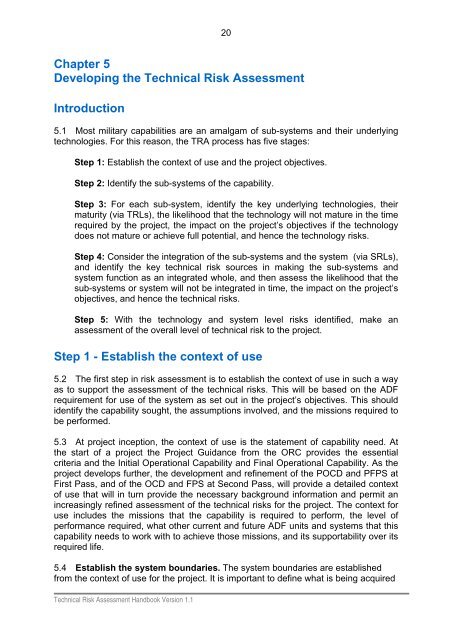Technical Risk Assessment Handbook - Defence Science and ...
Technical Risk Assessment Handbook - Defence Science and ...
Technical Risk Assessment Handbook - Defence Science and ...
Create successful ePaper yourself
Turn your PDF publications into a flip-book with our unique Google optimized e-Paper software.
20<br />
Chapter 5<br />
Developing the <strong>Technical</strong> <strong>Risk</strong> <strong>Assessment</strong><br />
Introduction<br />
5.1 Most military capabilities are an amalgam of sub-systems <strong>and</strong> their underlying<br />
technologies. For this reason, the TRA process has five stages:<br />
Step 1: Establish the context of use <strong>and</strong> the project objectives.<br />
Step 2: Identify the sub-systems of the capability.<br />
Step 3: For each sub-system, identify the key underlying technologies, their<br />
maturity (via TRLs), the likelihood that the technology will not mature in the time<br />
required by the project, the impact on the project’s objectives if the technology<br />
does not mature or achieve full potential, <strong>and</strong> hence the technology risks.<br />
Step 4: Consider the integration of the sub-systems <strong>and</strong> the system (via SRLs),<br />
<strong>and</strong> identify the key technical risk sources in making the sub-systems <strong>and</strong><br />
system function as an integrated whole, <strong>and</strong> then assess the likelihood that the<br />
sub-systems or system will not be integrated in time, the impact on the project’s<br />
objectives, <strong>and</strong> hence the technical risks.<br />
Step 5: With the technology <strong>and</strong> system level risks identified, make an<br />
assessment of the overall level of technical risk to the project.<br />
Step 1 - Establish the context of use<br />
5.2 The first step in risk assessment is to establish the context of use in such a way<br />
as to support the assessment of the technical risks. This will be based on the ADF<br />
requirement for use of the system as set out in the project’s objectives. This should<br />
identify the capability sought, the assumptions involved, <strong>and</strong> the missions required to<br />
be performed.<br />
5.3 At project inception, the context of use is the statement of capability need. At<br />
the start of a project the Project Guidance from the ORC provides the essential<br />
criteria <strong>and</strong> the Initial Operational Capability <strong>and</strong> Final Operational Capability. As the<br />
project develops further, the development <strong>and</strong> refinement of the POCD <strong>and</strong> PFPS at<br />
First Pass, <strong>and</strong> of the OCD <strong>and</strong> FPS at Second Pass, will provide a detailed context<br />
of use that will in turn provide the necessary background information <strong>and</strong> permit an<br />
increasingly refined assessment of the technical risks for the project. The context for<br />
use includes the missions that the capability is required to perform, the level of<br />
performance required, what other current <strong>and</strong> future ADF units <strong>and</strong> systems that this<br />
capability needs to work with to achieve those missions, <strong>and</strong> its supportability over its<br />
required life.<br />
5.4 Establish the system boundaries. The system boundaries are established<br />
from the context of use for the project. It is important to define what is being acquired<br />
<strong>Technical</strong> <strong>Risk</strong> <strong>Assessment</strong> <strong>H<strong>and</strong>book</strong> Version 1.1

















